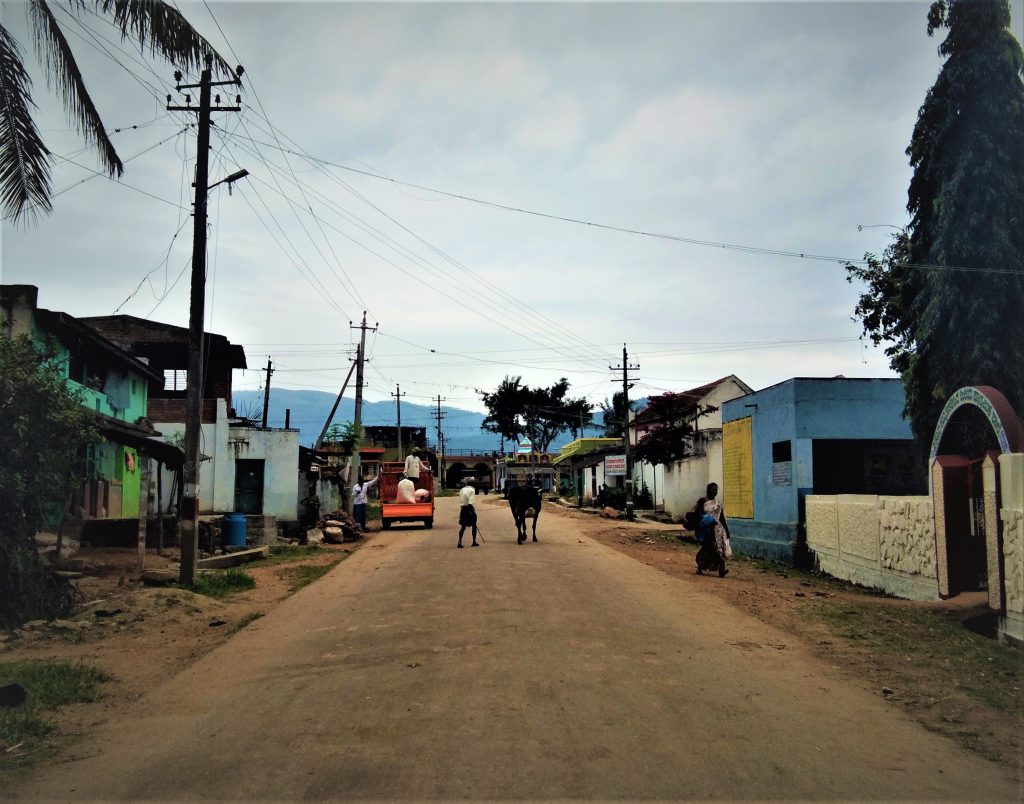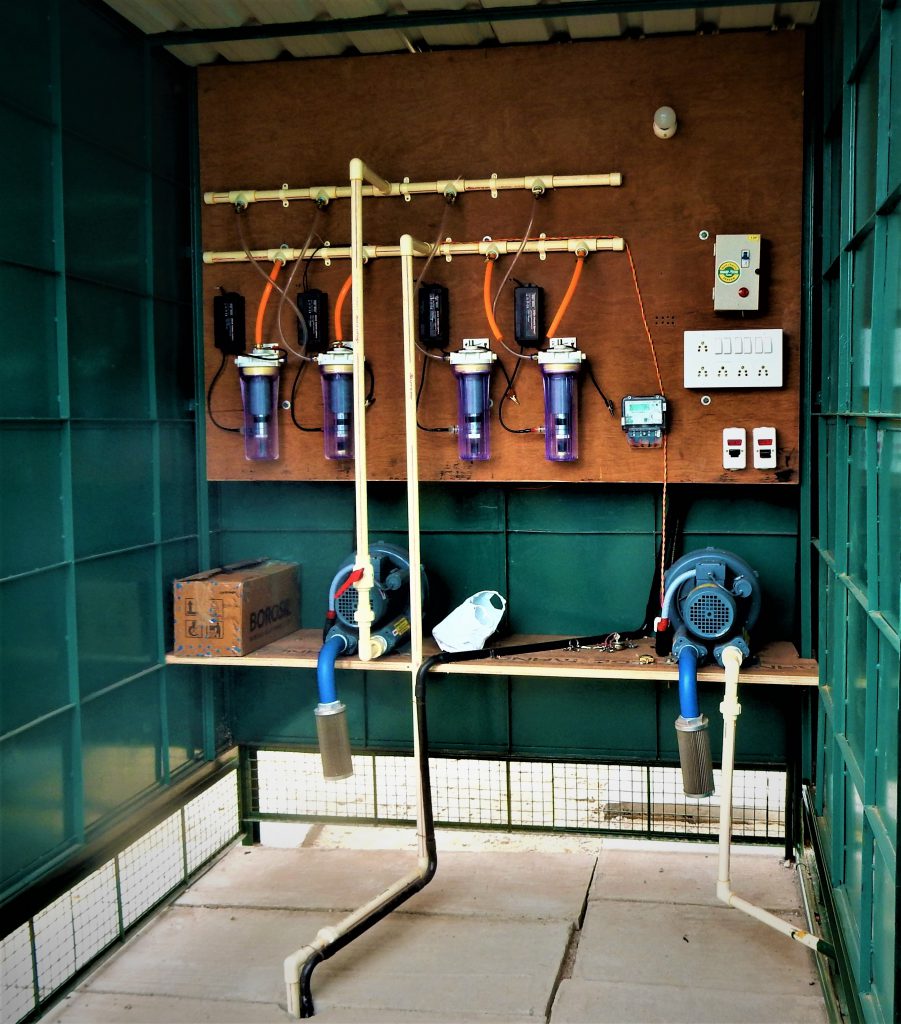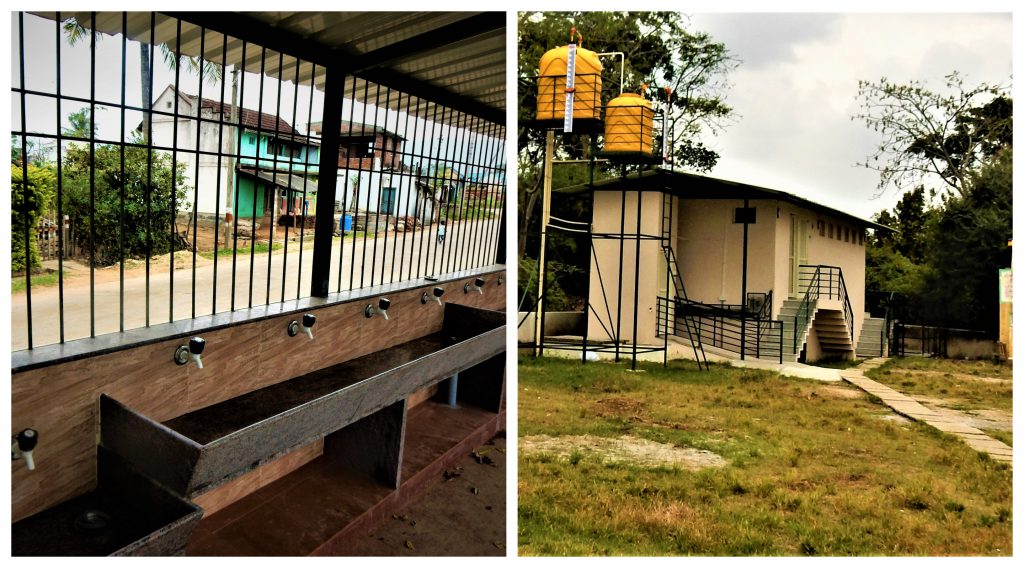A unique pilot project helmed by a team of scientists from India and Scotland

Berambadi (Photo: Rohini Krishnamurthy)
About 200 km southwest of Bengaluru is Berambadi, a village nestled between mountains, swathes of agricultural fields, the Hirikere lake, and the Bandipur National Park. This verdant countryside with tidy roads that borders Karnataka’s neighbours Kerala and Tamil Nadu is spellbinding. However, Berambadi, located in the rain shadow side of the Western Ghats, has been hit by drought several times in the last few years.
A small beginning has been made towards changing the situation. “We don’t face water scarcity in our school anymore,” says Jeevan S, a class eight student at the Berambadi government school – the site of a pilot project that, besides addressing water scarcity, aims to reduce pollution caused by untreated wastewater. This transformation has been enabled by an interdisciplinary team of experts from India and Scotland, including from IISc, working together to spruce up the wastewater treatment system in India.

Berambadi has water scarcity issues but it is not just this village that is facing the heat. According to a 2018 report by the NITI Aayog, 600 million people in India face water scarcity and 70 percent of the water supply is contaminated. The report also found that 54 percent of groundwater wells are declining and, at this rate, 21 major Indian cities may run out of groundwater by 2020.
One way to get around this problem is to treat and reuse wastewater. In urban India, wastewater is treated in centralised treatment plants. But only 32 percent of wastewater is treated, according to an analysis by the Centre for Science and Environment. The rest seeps into the ground, or finds its way into lakes, polluting them both along its way. Bellandur lake in Bengaluru is a striking example of how such untreated wastewater can wreak havoc. The lake is fed with untreated sewage – rich in phosphorus, nitrogen and other industrial effluents – causing it to froth and catch fire, most recently in January 2019. The city struggles to treat its sewage because many of the existing treatment plants are in a dismal state. And rapid urbanisation and population growth mean that Bengaluru is generating more sewage than it can handle.
To tackle this problem, the Karnataka High Court tasked apartment complexes in the state with more than 50 units to treat and reuse the wastewater they generate. This would reduce the burden on centralised wastewater treatment systems and freshwater sources and is hence considered a sustainable solution – but there are issues. Apartment complexes have to shell out lakhs of rupees to install such a decentralised system, depending on the capacity. Cheaper options exist, but function poorly. It was also reported that people are in a fix due to unclear guidelines on the kind of system to purchase and on how to maintain the plant. To make matters worse, several of these treatment plants have become dysfunctional, jeopardising the success of a decentralised system.
It is in this context that the project in the Berambadi school holds promise. “The idea behind this project”, says Lakshminarayana Rao, assistant professor at the Centre for Sustainable Technologies, IISc, “is to demonstrate that decentralised wastewater treatment system is the way to go.”
How it all began
The project, funded by the Government of Scotland, is a collaboration between IISc, the Ashoka Trust for Research in Ecology and the Environment, Bengaluru, the James Hutton Institute, Scotland, and the University of Glasgow.
According to Rachel Helliwell, project coordinator and senior research scientist at the James Hutton Institute, the Scottish government wanted to put more resources into international projects under their Hydro Nation International programme. The programme aims to share Scottish expertise and experience in the area of wastewater treatment with the wider world.
As to why they zeroed in on Berambadi, Rowen Ellis, a social scientist at the James Hutton Institute, explains that the main rationale was the familiarity: the hydrology of Berambadi is well-studied by IISc and other institutions. Besides the recent drought in Berambadi, the team factored in the local enthusiasm, the availability of land and the poor state of the school toilets. “All of this represents an opportunity to start from scratch and to construct a system that takes user experience and sanitation facility into account,” she adds.
The team of scientists chalked out plans to devise low-cost and environment-friendly methods to treat and reuse wastewater, while the social sciences team interacted with the villagers and students, educating them about the importance of the project and good sanitation practices
What makes this initiative special is the technology-meets-social sciences approach. The team of scientists chalked out plans to devise low-cost and environment-friendly methods to treat and reuse wastewater, while the social sciences team interacted with the villagers and students, educating them about the importance of the project and good sanitation practices. Innovation and social sciences need to work in tandem, according to Ellis. “A study published in 2014 concluded that there are at least two key issues that characterise the failure of sanitation initiatives,” she says. “First, is the poor, shoddy, unsuitable toilet construction and second, is that they failed to initiate any real and sustainable behaviour change.”
Before initiating the project, the team decided to gauge the extent of problems in Berambadi, from water quality and energy consumption to sanitation practices and other challenges. The survey revealed a very troubling picture, says Ellis. “We saw that the village heavily relied on groundwater; septic tanks were failing, and the untreated grey water was flowing into the school ground and drains.” A test of groundwater quality by Priyanka Jamwal, Fellow at ATREE, and her team found high levels of nitrates and faecal coliforms in the water. Armed with this baseline information, it took the team a year and a half to give the Berambadi school a new lease of life.
Going green
Rao and his team worked on a system to treat and reuse grey water – wastewater from the kitchen and hand wash – while the team from the James Hutton Institute focused on treating black water – wastewater from the toilet. The two systems function separately. “Keep it separate, clean it separately and your cost will come down,” adds Rao.
The goal was to direct the treated grey water for reuse in toilet flushes and gardening
The goal was to direct the treated grey water for reuse in toilet flushes and gardening. To do this, they designed a system where grey water is subjected to a series of steps: first is getting rid of the remnant fat and grease in the wastewater using a grease trapper. Water free of grease is passed through a trickling bed filter (a bed made of gravels of different sizes) and an aerator, where microorganisms help remove pollutants in the wastewater. This water, after undergoing the final step of disinfection, can be reused.
The common chemical used to disinfect is chlorine but it is not as effective as the more expensive ozone. Rao, however, wanted to develop a better technology at a lower cost. So he used plasma – ionised gas, the fourth state of matter – to generate ozone. “What we have developed in our lab is a high-throughput ozonator powered by solar energy, which can give out volumes of ozone at very low energy consumption,” says Rao.

To treat black water, the Scottish team channelled the flow of water from toilets into septic tanks, where the solid wastes separate and settle at the bottom while the liquid wastes or effluents flow into a trickling bed filter. Finally, the filtered water — high in phosphates and nitrates — is fed into the constructed wetlands, explains Samia Richards, an environmental scientist at the James Hutton Institute. Constructed wetlands can be thought of as ponds with plants growing on the surface – in this case, Canna lily, a flowering plant that can absorb the excess nitrates and phosphates from the wastewater. “Treated water from the constructed wetlands is then released into the sewage,” explains DK Manju, project assistant at Rao’s lab. This step checks frothing caused by eutrophication and groundwater contamination.
On the road ahead
The team went beyond just constructing the decentralised wastewater treatment system. In about a year and a half, they helped equip the school with a new hand wash area, solar panels, toilets, incinerators for sanitary pads, and a rainwater harvesting system with a capacity of 60,000 litres.
By recovering grey water and harvesting rainwater, the school should be able to halve its water consumption
According to Rao, the school – with a strength of about 200 children – consumes about 4,000 litres of water a day. By recovering grey water and harvesting rainwater, the school should be able to halve its water consumption.

“Now, we are in the process of working out the costs involved,” Rao says. “It’s not very expensive. Even with the best of the technologies, it costs about 25-27 rupees per thousand litres. In our technology, we want to bring it [costs] down anywhere in between 10 and 12 rupees per thousand litres.”
With the plant up and running, the team is relieved. But there is one major challenge. And that is to chart out the right maintenance plan. “If we don’t get this [maintenance] right, our system is going to fail,” says Helliwell. She explains that since the system mostly runs on its own, barring the ozonator and aerator, maintaining it on a daily basis wouldn’t be a hassle – all it needs is someone to control the switches for the aerator and the ozonator. But long-term maintenance requires engaging with the locals. “There are a lot of sewage treatment plants right now and they are not necessarily running the best. A part of the reason might be that we don’t have the skilled labour,” rues Rao. So the team is planning to introduce a youth internship programme, where youngsters will be trained to understand the system.
Elaborating on this, Durba Biswas, Fellow at the ATREE, says, “The genesis of the idea [youth internship programme] came from the fact that the school property is considered public property by the village people, which meant that anybody could come and go when the school is closed. This meant that there could be damage to the property, whether it is windows, doors.” So Biswas and her team decided to talk to the young people in the village, train those interested and give them incentives, maybe a certificate. The response, so far, has been good. “We received a lot of support from the school, even the community. Parents were willing to contribute 1 rupee per day, to help maintain the toilets. To you and me, it may not be a large amount of money. But to them, it is. This idea came from the community itself.”
The internship programme will take some time before it is rolled out. The team wants to ensure that the system is working well, before training the interns. “That is not to say that the entire maintenance falls on the interns. No. The primary objective is to embed the knowledge about the system in the community so that these people should know why this system is important and how the system works after we leave,” she adds.
“We are very keen to take this technology to other places, such as apartment complexes, hospitals, schools, and communities. We can replicate either parts of it or the complete project in other locations as well”
Rao is positive about the course of this project. Expressing his desire to collaborate, he says, “We are very keen to take this technology to other places, such as apartment complexes, hospitals, schools, and communities. We can replicate either parts of it or the complete project in other locations as well.” Though Richards shares Rao’s optimism, she adds that “each area will be different, and we’ll have to look at it differently. We have to look at the landscape, annual rainfall, vegetation and pollution.”
Before taking this further, the team is deliberating over another maintenance issue: to decide on the fate of the sludge from the septic tank. One solution they are considering is reusing the sludge.
There is already a technology to do just that, used by a Bangalore-based NGO named Consortium for DEWATS Dissemination Society (CDD). This technology, the faecal sludge treatment plant, is housed in a small town in Bengaluru called Devanahalli. To establish this plant, the CDD partnered with Devanahalli’s Town Municipal Cooperation. Here they co-compost treated faecal sludge with municipal wet waste, which, according to their laboratory tests, keeps pathogens out of the final manure. They also find that the co-composted manure improves the water-holding capacity of the soil, and increases crop yield. The co-composted manure, the CDD says, has seen demand from the farmers in Devanahalli.
Talking about support from the government, the CDD says that though the Swachh Bharat Mission — covering 4,041 statutory towns, cities and rural India — has a small budget, they believe that there is scope for public-private partnerships and new types of investment to come in. Of the states the CDD has approached, they have found Tamil Nadu to be the most progressive. Other states, including Karnataka, have not been as responsive, which they feel may have to do with the fact that Faecal Sludge Management (FSM) is still relatively unheard of.
Nevertheless, the CDD finds support at the national level. According to them, the central government has allocated budgets for sanitation or FSM, and the like. With an emphasis on FSM in AMRUT [Atal Mission for Rejuvenation and Urban Transformation, under the Ministry of Housing and Urban Affairs], they believe that the government is actively learning and doing the best they can.
Over the next few months, they will periodically test water quality in the Berambadi school, at different stages of water treatment
It remains to be seen if faecal sludge treatment will be employed in the Berambadi project by the Indo-Scottish team. Over the next few months, they will periodically test water quality in the Berambadi school, at different stages of water treatment. And if it all works well, the system could be replicated with support from the Government of Karnataka.
Meanwhile, a farmer living across the school in Berambadi named Swami, whose daughter studies at the school, is aware and happy about the developments. “Things are good and convenient now. My daughter is happy. I hope everything is maintained properly.”




